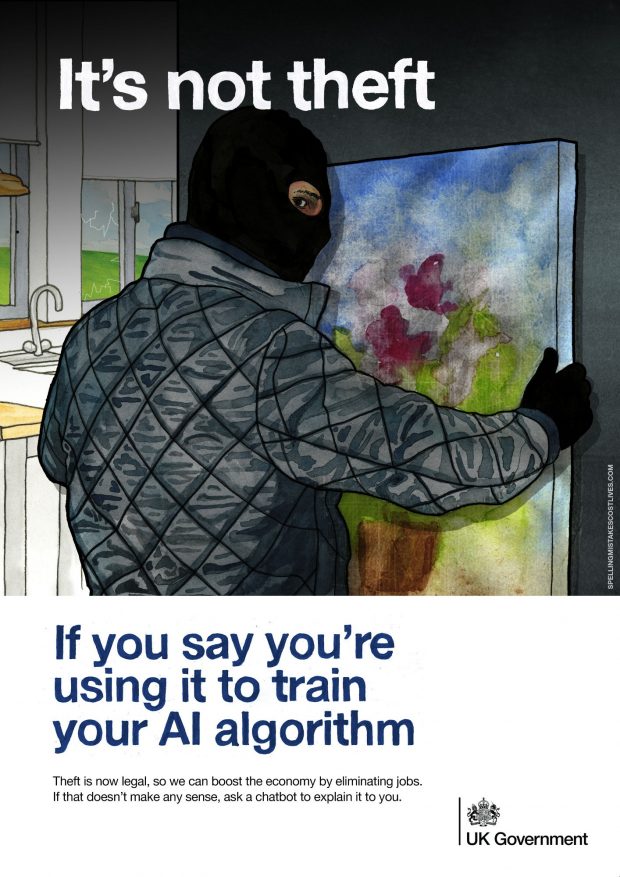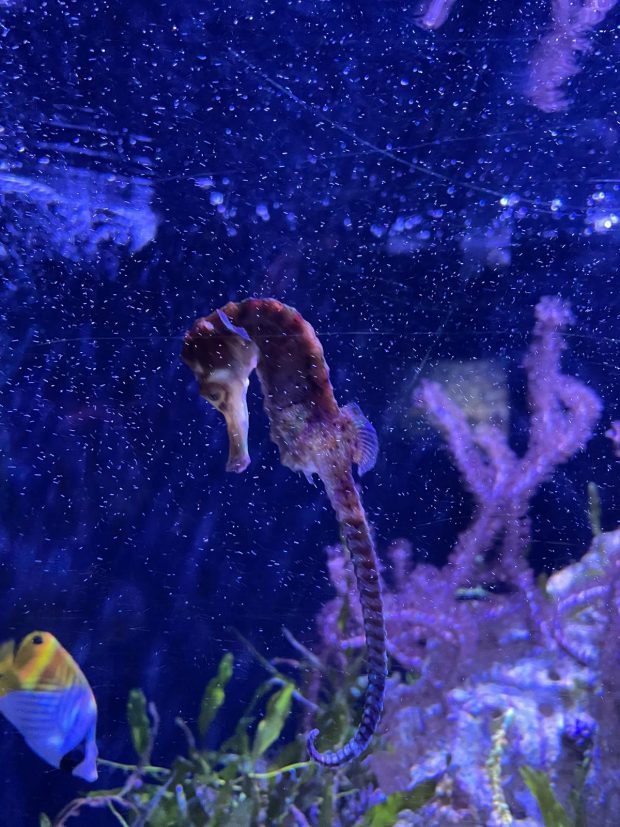

Ask this question chatGPT – and it starts rattling like a shaken pinball machine…

Here is an explanation of that phenomenon by Brian Huang
if the model wants to output the word “hello”, it needs to construct a residual similar to the vector for the “hello” output token that the lm_head can turn into the hello token id. and if the model wants to output a seahorse emoji, it needs to construct a residual similar to the vector for the seahorse emoji output token(s) – which in theory could be any arbitrary value, but in practice is seahorse + emoji in word2vec style.
The only problem is the seahorse emoji doesn’t exist! So when this seahorse + emoji residual hits the lm_head, it does its dot product over all the vectors, and the sampler picks the closest token – a fish emoji.
For an even longer version see [here].
Bonus 1 – here is a my seahorse image taken at the Musée océanographique de Monaco last week from its wonderful collection. Let‘s forget the virtual world and preserve the real one.

Bonus 2 – the answer to a long-standing question: The origin of male seahorses’ brood pouch!
It’s making the rounds now – Andrew Gelman has already a long post – how authors of scientific papers are trying prompt injections for lazy reviewers that let a LLM write their review.

We do not need to discuss all dystopic X posts about LLMs.

Whenever Nature Mag, however, publishes nonsense like “A foundation model to predict and capture human cognition” this may deserve a comment…
Fortunately Science’s Cathleen O’Grady already commented
“I think there’s going to be a big portion of the scientific community that will view this paper very skeptically and be very harsh on it” says Blake Richards, a computational neuroscientist at McGill University … Jeffrey Bowers, a cognitive scientist at the University of Bristol, thinks the model is “absurd”. He and his colleagues tested Centaur … and found decidedly un-humanlike behavior.”
The claim is absurd as training set of 160 psych studies was way to small to cover even a minor aspect of human behavior.
And well, a large fraction of the 160 published study findings are probably wrong as may be assumed from another replications study in psych field
Ninety-seven percent of original studies had significant results … Thirty-six percent of replications had significant results.

War das ein Aprilscherz? Nein, offensichtlich nicht, obwohl am 1.4. veröffentlicht.
Aber gibt es ja auch in Berlin so ein dubioses “Forschungszentrum” am Institut für Sozialmedizin, Epidemiologie und Gesundheitsökonomie der Charité.
Und Cochrane: Waren das nicht die EBM Evidenzfetischisten die sowohl gegen Testen und Masken waren und die gerade pleite sind trotz Alimente?
https://chatgpt.com/share/67e9741d-bcf4-8000-bb60-26dc50e6fa5f
Where was the closest sequence observed before the first COVID-19 sequence?
The closest known sequence to the first identified SARS-CoV-2 genome (from Wuhan, China, in December 2019) comes from bat coronaviruses, particularly RaTG13, which was found in a bat (Rhinolophus affinis) in Yunnan, China, in 2013. RaTG13 shares about 96.2% genetic similarity with SARS-CoV-2, making it the closest known relative at the time. Additionally, other similar sequences, such as BANAL-52, BANAL-103, and BANAL-236, were later discovered in bats in Laos, showing even closer similarity in certain regions of the genome. Would you like more details on these related viruses?
Continue reading I asked chatGPT about SARS-CoV-2 genome similarities and this is what I got
„Ich bin Professorin an der Fachhochschule XY und erkläre meinen Studierenden, wie sie ihre Meinung am besten ungefiltert an die Adressaten bringen, denn das legitimiert in Zeiten der postfaktischen Politik.”

Wikipedia listet die Absolventenliste dieser FH
I have occasionally selected a paper of the year, that I enjoyed most for reading. Usually this was not a breakthrough paper but a more hidden pearl. BMJ Christmas and Ig Nobel 2024 were funny, sure, but here is my selection from the literature, a correspondence
Can a biologist fix a radio? — Or, what I learned while studying apoptosis Cancer Cell Volume 2, Issue 3 P179-182 September 2002
A more successful approach will be to remove components one at a time or to use a variation of the method, in which a radio is shot at a close range with metal particles. In the latter case radios that malfunction (have a “phenotype”) are selected to identify the component whose damage causes the phenotype. Although removing some components will have only an attenuating effect, a lucky postdoc will accidentally find a wire whose deficiency will stop the music completely. The jubilant fellow will name the wire Serendipitously Recovered Component (Src) and then find that Src is required because it is the only link between a long extendable object and the rest of the radio. The object will be appropriately named the Most Important Component (Mic) of the radio. A series of studies will definitively establish that Mic should be made of metal and the longer the object is the better, which would provide an evolutionary explanation for the finding that the object is extendable.
Just for the records.
Famous soccer coach Jürgen Klopp 2020 about COVID-19
Less famous Robert F Kennedy 2024 about polio vaccination
(and response by 75 Nobel laureates).

“Lacking a comprehensive anarchist worldview and philosophy, and in any case wary of nomothetic ways of seeing, I am making a case for a sort of anarchist squint.” James Scott in “Two Cheers for Anarchism” who writes Pletz when he means Datzetal-Pleetz
Title: Quantum-Tuned Allergen Resonance Therapy (QT-ART): A Revolutionary Cure for Allergies
Recent advances in bio-resonance and quantum biophotonics have culminated in the development of Quantum-Tuned Allergen Resonance Therapy (QT-ART), a groundbreaking approach to eradicating allergic reactions. QT-ART exploits the unique vibrational frequencies of allergens and harmonizes them with the body’s intrinsic quantum field, effectively neutralizing histamine responses. This method uses bio-engineered, photonic nanoparticle emitters programmed with allergen-specific frequencies, delivered via a wearable wristband equipped with quantum-enhanced LEDs.
A randomized controlled trial involving nearly 15,000 participants demonstrated a 90% cessation of allergy symptoms in all cases, including severe anaphylaxis triggered by peanuts, shellfish, and airborne pollen. Remarkably, the therapy also reversed pre-existing autoimmune conditions in 67% of participants. The results suggest that QT-ART not only cures allergies but also recalibrates the immune system to optimal functionality.
Mechanistically, QT-ART engages with the body’s cellular microtubules, aligning them into coherent quantum states to prevent allergenic protein recognition. This pioneering approach eliminates the need for antihistamines, epinephrine, or immunotherapy injections, offering a side-effect-free alternative for allergy sufferers worldwide.
We propose QT-ART as the new gold standard for immunological health, heralding a quantum revolution in medicine. Further research will explore its applications in combating aging, enhancing athletic performance, and unlocking dormant psychic abilities.
Keywords: quantum resonance, allergy cure, biophotonics, immune recalibration, quantum medicine
(AI generated!!)
Being a regular Scholar user, I am quite lost now with the many new scientific search engines. They don’ tell us which data they used for training, how they have been trained and how the results have been validated. The field is also highly dynamic when compared to the situation 2 years ago. Is it worth to test them?

Continue reading Too many AI powered scientific search engines
Treffen sich 2 Historiker.
„Worüber arbeiten Sie“
„Ach, über den 6.11.2024“
„Oh, ich auch. Über den Vormittag oder Nachmittag?“